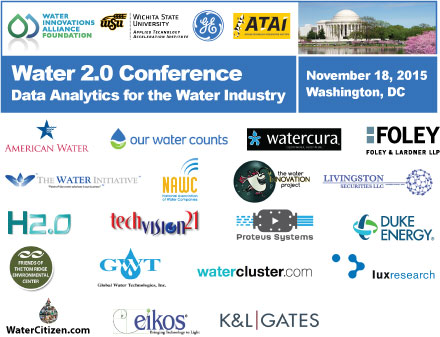Speaker Announcement – Water 2.0 Conference 11/18 Washington DC
Posted on July 22nd, 2015 in Uncategorized | No Comments »
The Water Innovations Alliance Foundation is proud to announce the Speaker Lineup for our Water 2.0 Conference – Data Analytics for the Water Industry.
Water 2.0 – Data Analytics for the Water Industry Conference
Wednesday, November 18, 2015
Conference Location:
Foley & Lardner LLP
3000 K Street, NW, Suite 600
Washington, DC 20007-5109
Water enters the digital era. Big Data Solutions, Information Powered Utilities and Smarter Customers. The Water 2.0 – Data Analytics for the Water Industry Conference will focus on the use of data analytics, software and cyber security for water utilities. Participants will include water and energy industry authorities, utilities professionals and representatives from the EPA. Registration will open at 8:AM. Lunch is included in the registration fee. The conference will wrap-up at 5:PM followed by networking.
REGISTER TODAY – $250
Speakers for the Water 2.0 – Data Analytics for the Water Industry Conference include:
Chanley T. Howell, Partner, Foley & Lardner, LLP
Kenneth E. Russell, Ph.D., Executive Director, Applied Technology Acceleration Institute – Wichita State University
Robert J. Gates, P.E., Global Marketing Director Manufacturing, GE Intelligent Platforms
Christopher Peacock, Director Strategic Accounts, FATHOM
Paul Gagliardo, M.P.H., P.E., Manager – Innovation Development, American Water
Alan Hinchman, Chief Operating Officer, The Water Initiative
David Schoenberger, CIO, Secure Cloud Systems, LLC
Erik Hromadka, CEO, Global Water Technologies, Inc.
Richard E. Hyman, Author of FROGMEN
——————————————————————-
WATER NEWS
The Conference Treadmill
By Christopher Peacock
GE – Our Water Counts Blog
California Rain Showers: Small Things Matter
By Erik Hromadka
GE – Our Water Counts Blog
Protect What You Love
By Richard Hyman
GE – Our Water Counts Blog
The Power of One: A Tall Order for Overcoming Water Shortage
By Jill Burdette
GE – Our Water Counts Blog
The Drought Comes East: All Water Is Local
By Vincent Caprio
GE – Our Water Counts Blog
——————————————————————–
CORPORATE MEMBERSHIP
Please join our roster of Corporate Members. For further information, please contact Vincent Caprio vince@waterinnovationsfoundation.org or 203-733-1949 to discuss.
——————————————————————–
INDIVIDUAL MEMBERSHIP
We encourage individuals interested in continuing our efforts to provide information in regard to emerging water technologies to become individual members of the WIAF. Click here to become a WIAF Individual Member. The annual Individual Membership fee is $100.
——————————————————————–
Looking forward to seeing you on November 18th in Washington, DC.





